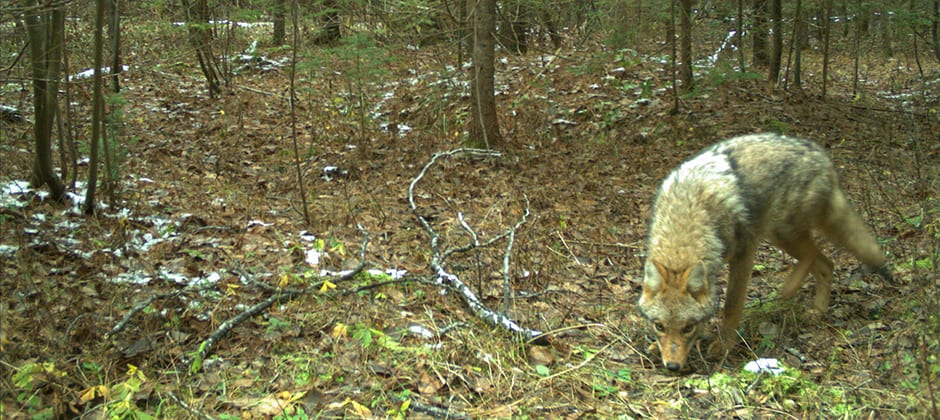Share this article
Which coyotes are the ‘top dogs?’
Coyotes in the Lower Peninsula of Michigan consume more meat than those in the Upper Peninsula, researchers found. That’s because coyotes (Canis latrans) in the Upper Peninsula are surrounded by gray wolves (Canis lupus), pushing coyotes lower down on the trophic pyramid and making wolves the top dogs.
“It’s interesting. As a wildlife biologist, people ask me ‘what’s your favorite animal,’” said Nyeema Harris, an assistant professor and director of the Applied Wildlife Ecology Lab at the University of Michigan. “I don’t have a favorite animal, just ones that are really interesting to me. And one I find really interesting is coyotes.”

Researchers collected coyote scat like this to conduct isotope analysis and learn more about their diets.
Credit: Applied Wildlife Ecology (AWE) Lab, University of Michigan
That’s because the species can be found anywhere from mountains to cities, from the West to the East to the deserts of Mexico, Harris said. “It’s interesting to see their flexibility and adaptability in Michigan, which is a diverse state with a natural gradient of environmental conditions,” she said. The Upper Peninsula is wild, remote and open. The Lower Peninsula is more populated and its historical forests have been more heavily logged.
In a study published in the Journal of Animal Ecology, Harris and her colleagues set out to determine the diets and microbial communities of coyotes in different parts of the state. They looked at three sites — one in the Upper Peninsula and two in the Lower Peninsula. They have now added Detroit to study urban coyotes.
“We spent a lot of time looking for poop,” Harris said, “but we had a good time doing it.” Hiking in the woods looking for animal sign, they collected the scat they found, determined which came from coyotes and conducted isotope analyses to figure out what the coyotes were eating. Higher levels of nitrogen isotopes signaled when coyotes were consuming more meat.
Coyotes in the Upper Peninsula were consuming less meat, researchers found, due in part to top-down pressures from gray wolves in the region. In the Lower Peninsula where coyotes were the “top dogs,” Harris said, they were consuming lots of meat.
The team also looked at the gut microbiome of coyotes across the sites. “We wanted to see if there were any associations between diet signatures and microbial communities and found a relationship,” Harris said. What the coyotes ate influenced their gut microbiomes, same as for people.
As coyotes expand across the continent, understanding their diets is particularly important, Harris said. While people often worry their pet cats will become coyote prey, “it’s more likely that they’ll eat your trash,” Harris said. “These kinds of studies allow us to have those conversations and allow us to promote strategies for thinking about coexistence and how we live with our wildlife neighbors.”
The team plans to continue collecting scat samples across the different populations along with camera trap data to help them answer more questions about coyotes’ diet preferences.
“We can document what foods coyotes are eating across their range and if there’s variation in the actual species they select and if that changes across populations,” she said.
Header Image:
Coyotes in Michigan’s Lower Peninsula consume more meat than those in the Upper Peninsula.
Credit: Applied Wildlife Ecology (AWE) Lab, University of Michigan








